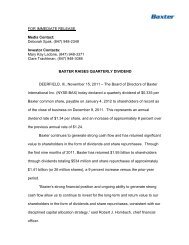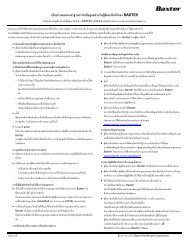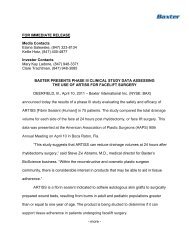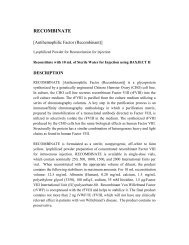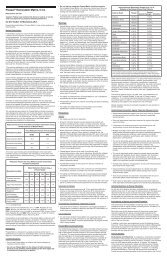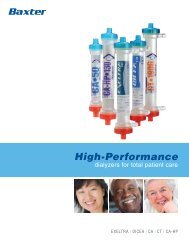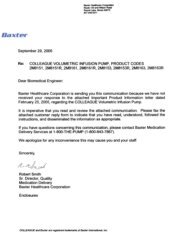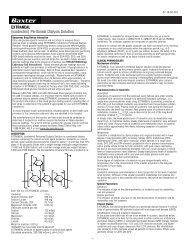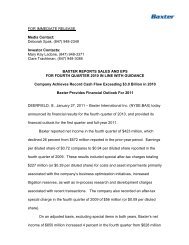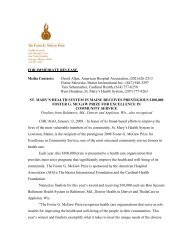BUMINATE 25%, Albumin (Human), USP, 25% Solution - Baxter
BUMINATE 25%, Albumin (Human), USP, 25% Solution - Baxter
BUMINATE 25%, Albumin (Human), USP, 25% Solution - Baxter
You also want an ePaper? Increase the reach of your titles
YUMPU automatically turns print PDFs into web optimized ePapers that Google loves.
<strong>BUMINATE</strong> <strong>25%</strong>, <strong>Albumin</strong> (<strong>Human</strong>), <strong>USP</strong>, <strong>25%</strong> <strong>Solution</strong><br />
DESCRIPTION<br />
<strong>BUMINATE</strong> <strong>25%</strong>, in 20, 50 and 100 mL glass bottles is a sterile, nonpyrogenic preparation of albumin<br />
in a single dosage form for intravenous administration. Each 100 mL contains 25 g of albumin and<br />
was prepared from human venous plasma using the Cohn cold ethanol fractionation process. Source<br />
material for fractionation may be obtained from another U.S. licensed manufacturer. It has been<br />
adjusted to physiological pH with sodium bicarbonate and/or sodium hydroxide and stabilized with<br />
N-acetyltryptophan (0.02 M) and sodium caprylate (0.02 M). The sodium content is 145 ± 15 mEq/L.<br />
This solution contains no preservative and none of the coagulation factors found in fresh whole blood<br />
or plasma. <strong>BUMINATE</strong> <strong>25%</strong> is a transparent or slightly opalescent solution which may have a<br />
greenish tint or may vary from a pale straw to an amber color.<br />
The likelihood of the presence of viable hepatitis viruses has been minimized by testing the plasma<br />
at three stages for the presence of hepatitis viruses, by fractionation steps with demonstrated virus<br />
removal capacity and by heating the product for 10 hours at 60°C. This procedure has been shown<br />
to be an effective method of inactivating hepatitis virus in albumin solutions even when those<br />
solutions were prepared from plasma known to be infective. 1-3<br />
ClINICAl PHARMACOlOgy<br />
<strong>Albumin</strong> is responsible for 70-80% of the colloid osmotic pressure of normal plasma, thus making it<br />
useful in regulating the volume of circulating blood. 4-6 <strong>Albumin</strong> is also a transport protein and binds<br />
naturally occurring, therapeutic and toxic materials in the circulation. 5,6<br />
<strong>BUMINATE</strong> <strong>25%</strong> is osmotically equivalent to approximately five times its volume of human plasma.<br />
When injected intravenously, <strong>25%</strong> albumin will draw about 3.5 times its volume of additional fluid<br />
into the circulation within 15 minutes, except when the patient is markedly dehydrated. This extra<br />
fluid reduces hemoconcentration and blood viscosity. The degree and duration of volume expansion<br />
depends upon the initial blood volume. With patients treated for diminished blood volume, the effect<br />
of infused albumin may persist for many hours; however, in patients with normal volume, the<br />
duration will be shorter. 7-9<br />
Total body albumin is estimated to be 350 g for a 70 kg man and is distributed throughout the<br />
extracellular compartments; more than 60% is located in the extravascular fluid compartment. The<br />
half-life of albumin is 15 to 20 days with a turnover of approximately 15 g per day. 5<br />
The minimum plasma albumin level necessary to prevent or reverse peripheral edema is unknown.<br />
Some investigators recommend that plasma albumin levels be maintained at approximately<br />
2.5 g/dL. This concentration provides a plasma oncotic pressure value of 20 mm Hg. 4<br />
<strong>BUMINATE</strong> <strong>25%</strong> is manufactured from human plasma by the modified Cohn-Oncley cold ethanol<br />
fractionation process, which includes a series of cold-ethanol precipitation, centrifugation and/or<br />
filtration steps followed by pasteurization of the final product at 60 ± 0.5°C for 10–11 hours. This<br />
process accomplishes both purification of albumin and the reduction of viruses.<br />
In vitro studies demonstrate that the manufacturing process for <strong>BUMINATE</strong> <strong>25%</strong> provides for significant<br />
viral reduction. These viral reduction studies, summarized in Table 1, demonstrate viral clearance during<br />
the manufacturing process for <strong>BUMINATE</strong> <strong>25%</strong> using human immunodeficiency virus, type 1 (HIV-1)<br />
both as a target virus and as model virus for HIV-2 and other lipid-enveloped RNA viruses; bovine viral<br />
diarrhea virus (BVDV), a model for lipid-enveloped RNA viruses, such as hepatitis C virus (HCV); West<br />
Nile Virus (WNV), a target virus and model for other similar lipid-enveloped RNA viruses; pseudorabies<br />
virus (PRV), a model for other lipid-enveloped DNA viruses such as hepatitis B virus (HBV); mice minute<br />
virus (MMV), models for non-enveloped DNA viruses such as human parvovirus B1910 ; hepatitis A virus<br />
(HAV), a target virus and a model for other non-enveloped RNA viruses.<br />
These studies indicate that specific steps in the manufacture of <strong>BUMINATE</strong> <strong>25%</strong> are capable of<br />
eliminating/inactivating a wide range of relevant and model viruses. Since the mechanism of virus<br />
elimination/inactivation by fractionation and by heating is different, the overall manufacturing<br />
process of <strong>BUMINATE</strong> <strong>25%</strong> is robust in reducing viral load.<br />
TABlE 1<br />
Summary of Viral Reduction Factor for Each Virus and Processing Step<br />
Viral Reduction Factor (log ) 10<br />
Process Step<br />
Processing of Fraction I+II+III/II+III supernatant<br />
to Fraction IV 4 Cuno 70C filtrate*<br />
lipid Enveloped Non-lipid Enveloped<br />
HIV-1<br />
Flaviviridae<br />
BVDV WNV<br />
PRV HAV<br />
Parvoviridae<br />
MMV<br />
> 4.9 > 4.8 > 5.7 > 5.5 > 4.5 3.0<br />
Pasteurization > 7.8 > 6.5 n.d. > 7.4 3.2 1.6**<br />
Mean Cumulative Reduction Factor, log 10 > 12.7 > 11.3 > 5.7 > 12.9 > 7.7 4.6<br />
n.d. = not determined<br />
* Other <strong>Albumin</strong> fractionation process steps (processing of cryo-poor plasma to Fractionation I+II+III/II+III supernatant and processing of<br />
Fraction V suspension to Cuno 90LP filtrate) showed significant virus reduction capacity in in-vitro viral clearance studies. These process<br />
steps also contribute to the overall viral clearance robustness of the manufacturing process. However, since the mechanism of virus<br />
removal is similar to that of this particular process step, the viral inactivation data from other steps were not used in the calculation of the<br />
Mean Cumulative Reduction Factor.<br />
** Recent scientific data suggests that the actual human parvovirus B19 (B19V), is far more effectively inactivated by pasteurization than<br />
indicated by model virus data. 10<br />
INDICATIONS AND USAgE<br />
1. Hypovolemia<br />
Hypovolemia is a possible indication for use of <strong>BUMINATE</strong> <strong>25%</strong>. Its effectiveness in reversing<br />
hypovolemia depends largely upon its ability to draw interstitial fluid into the circulation. It is most<br />
effective with patients who are well hydrated. When the hypovolemia is long standing and<br />
hypoalbuminemia exists accompanied by adequate hydration or edema, <strong>25%</strong> albumin is preferable<br />
to 5% protein solutions. 4,6 However, in the absence of adequate or excessive hydration, 5% protein<br />
solutions should be used or <strong>25%</strong> albumin should be diluted with crystalloid solutions.<br />
Although crystalloid solutions and colloid-containing plasma substitutes can be used in<br />
emergency treatment of shock, <strong>Albumin</strong> (<strong>Human</strong>) has a prolonged intravascular half-life. 11<br />
When blood volume deficit is the result of hemorrhage, compatible red blood cells or whole blood<br />
should be administered as quickly as possible.<br />
2. Hypoalbuminemia<br />
A. General<br />
Hypoalbuminemia is another possible indication for use of <strong>BUMINATE</strong> <strong>25%</strong>. Hypoalbuminemia<br />
can result from one or more of the following: 5<br />
(1) Inadequate production (malnutrition, burns, major injury, infections, etc.)<br />
(2) Excessive catabolism (burns, major injury, pancreatitis, etc.)<br />
(3) Loss from the body (hemorrhage, excessive renal excretion, burn exudates, etc.)<br />
(4) Redistribution within the body (major surgery, various inflammatory conditions, etc.)<br />
When albumin deficit is the result of excessive protein loss, the effect of administration of<br />
albumin will be temporary unless the underlying disorder is reversed. In most cases,<br />
increased nutritional replacement of amino acids and/or protein with concurrent treatment of<br />
the underlying disorder will restore normal plasma albumin levels more effectively than<br />
albumin solutions. Occasionally hypoalbuminemia accompanying severe injuries, infections or<br />
pancreatitis cannot be quickly reversed and nutritional supplements may fail to restore serum<br />
albumin levels. In these cases, <strong>BUMINATE</strong> <strong>25%</strong> might be a useful therapeutic adjunct.<br />
B. Burns<br />
An optimum regimen for the use of albumin, electrolytes and fluid in the early treatment of burns<br />
has not been established, however, in conjunction with appropriate crystalloid therapy,<br />
<strong>BUMINATE</strong> <strong>25%</strong> may be indicated for treatment of oncotic deficits after the initial 24-hour period<br />
following extensive burns and to replace the protein loss which accompanies any severe burn. 4,6<br />
C. Adult Respiratory Distress Syndrome (ARDS)<br />
A characteristic of ARDS is a hypoproteinemic state, which may be causally related to the<br />
interstitial pulmonary edema. Although uncertainty exists concerning the precise indication of<br />
albumin infusion in these patients, if there is a pulmonary overload accompanied by<br />
hypoalbuminemia, <strong>25%</strong> albumin solution may have a therapeutic effect when used with a diuretic. 4<br />
D. Nephrosis<br />
<strong>BUMINATE</strong> <strong>25%</strong> may be a useful aid in treating edema in patients with severe nephrosis who<br />
are receiving steroids and/or diuretics.<br />
3. Cardiopulmonary Bypass Surgery<br />
<strong>BUMINATE</strong> <strong>25%</strong> has been recommended prior to or during cardiopulmonary bypass surgery,<br />
although no clear data exist indicating its advantage over crystalloid solutions. 4,6,12<br />
4. Hemolytic Disease of the Newborn (HDN)<br />
<strong>BUMINATE</strong> <strong>25%</strong> may be administered in an attempt to bind and detoxify unconjugated bilirubin in<br />
infants with severe HDN.<br />
There is no valid reason for use of albumin as an intravenous nutrient.<br />
CONTRAINDICATIONS<br />
A history of allergic reactions to albumin and any of the excipients is a specific contraindication to<br />
the use of this product.<br />
<strong>BUMINATE</strong> <strong>25%</strong> is also contraindicated in severely anemic patients and in patients with cardiac failure.<br />
<strong>BUMINATE</strong> <strong>25%</strong> must not be diluted with Sterile Water for Injection as this may cause hemolysis in<br />
recipients. There exists a risk of potentially fatal hemolysis and acute renal failure from the use of<br />
Sterile Water for Injection as a diluent for <strong>Albumin</strong> (<strong>Human</strong>). Acceptable diluents include 0.9%<br />
Sodium Chloride or 5% Dextrose in Water.<br />
<strong>BUMINATE</strong> <strong>25%</strong> must not be administered to patients with chronic renal insufficiencies due to the<br />
potential for accumulations of aluminum. Accumulations of aluminum in patients with chronic renal<br />
insufficiencies have led to toxic manifestations such as hypercalcemia, vitamin D-refractory<br />
13-15, 19<br />
osteodystrophy, anemia, and severe progressive encephalopathy.<br />
WARNINgS<br />
<strong>BUMINATE</strong> <strong>25%</strong> is made from human plasma. Products made from human plasma may<br />
contain infectious agents, such as viruses, that can cause disease. This also applies to<br />
unknown or emerging viruses and pathogens.<br />
The risk that such products will transmit an infectious agent has been reduced by screening<br />
plasma donors for prior exposure to certain viruses, by testing for the presence of certain<br />
current virus infections, and by inactivating and/or removing certain viruses (See<br />
Description). The measures taken are considered effective for enveloped viruses such as HIV,<br />
HBV, and HCV, and for the non-enveloped viruses HAV and Parvovirus B19. Despite these<br />
measures, such products can still potentially transmit disease. Based on effective donor<br />
screening and product manufacturing processes, albumin carries an extremely remote risk<br />
for transmission of viral diseases. A theoretical risk for transmission of Creutzfeldt-Jakob<br />
disease (CJD) also is considered extremely remote. No cases of transmission of viral diseases<br />
or CJD have ever been identified for albumin. All infections thought by a physician possibly<br />
to have been transmitted by this product, should be reported by the physician, or other<br />
healthcare provider to <strong>Baxter</strong> Healthcare Corporation at 1-800-423-2862. The physician<br />
should discuss the risks and benefits of this product with the patient.<br />
Suspicion of allergic or anaphylactic type reactions requires immediate discontinuation of the<br />
injection. In case of shock, standard medical treatment for shock should be implemented.<br />
PRECAUTIONS<br />
Certain components used in the packaging of this product contain natural rubber latex.<br />
Hemodynamics<br />
Do not administer <strong>BUMINATE</strong> <strong>25%</strong> without very close monitoring of hemodynamics; look for<br />
evidence of cardiac or respiratory failure, renal failure, or increasing intra-cranial pressure.<br />
Hypervolemia/Hemodilution<br />
<strong>BUMINATE</strong> <strong>25%</strong> should be used with caution in conditions where hypervolemia and its<br />
consequences or hemodilution could represent a special risk for the patient. Examples may include<br />
but are not limited to: decompensated cardiac insufficiency, hypertension, esophageal varices,<br />
pulmonary edema, hemorrhagic diathesis, severe anemia, renal and post-renal failure.<br />
<strong>BUMINATE</strong> <strong>25%</strong> must be administered intravenously. The rate of administration should be adjusted<br />
according to the solution concentration and the patient’s hemodynamic measurements and should<br />
not exceed 1mL/min to patients with normal blood volume. More rapid administration might cause<br />
circulatory overload and pulmonary edema. 16 At the first clinical signs of cardiovascular overload<br />
(headache, dyspnea, jugular vein congestion), or increased<br />
blood pressure, raised central venous pressure and<br />
pulmonary edema, the infusion is to be stopped immediately.
Blood Pressure<br />
A rise in blood pressure after <strong>25%</strong> albumin infusion necessitates careful observation of the injured or<br />
post-operative patient in order to detect and treat severed blood vessels that may not have bled at a<br />
lower blood pressure.<br />
Pregnancy–Category C, and lactation<br />
There are no adequate data from the use of <strong>BUMINATE</strong> <strong>25%</strong> in pregnant or lactating women.<br />
Animal reproduction studies have not been conducted with <strong>BUMINATE</strong> <strong>25%</strong>. It is not known whether<br />
<strong>BUMINATE</strong> <strong>25%</strong> can cause fetal harm when administered to a pregnant woman or can affect<br />
reproductive capacity. Physicians should carefully consider the potential risks and benefits for each<br />
specific patient before prescribing <strong>BUMINATE</strong> <strong>25%</strong>. <strong>BUMINATE</strong> <strong>25%</strong> should be given to a pregnant<br />
woman only if clearly needed.<br />
Pediatric Use<br />
The safety of albumin solutions has been demonstrated in children provided the dose is appropriate<br />
for body weight. However, the safety of <strong>BUMINATE</strong> <strong>25%</strong> has not been evaluated in pediatric patients.<br />
large Volumes<br />
If comparatively large volumes are to be replaced, controls of coagulation and hematocrit are<br />
necessary. Care must be taken to ensure adequate substitution of other blood constituents<br />
(coagulation factors, electrolytes, platelets, and erythrocytes). Appropriate hemodynamic monitoring<br />
should be undertaken.<br />
Electrolyte Status<br />
When <strong>BUMINATE</strong> <strong>25%</strong> is given, the electrolyte status of the patient should be monitored and<br />
appropriate steps taken to restore or maintain the electrolyte balance.<br />
DRUg INTERACTIONS<br />
No interaction studies have been performed with <strong>BUMINATE</strong> <strong>25%</strong>.<br />
ADVERSE REACTIONS<br />
Adverse Reactions from Clinical Trials<br />
There are no data available on adverse reactions from clinical trials conducted with <strong>BUMINATE</strong> <strong>25%</strong>.<br />
Post-Marketing Adverse Reactions<br />
The following adverse reactions have been reported in the post-marketing experience. These reactions<br />
are listed by MedDRA System Organ Class (SOC), then by Preferred Term in order of severity.<br />
IMMUNE SYSTEM DISORDERS: Anaphylactic shock, Anaphylactic reactions, Hypersensitivity/Allergic reactions<br />
NERVOUS SYSTEM DISORDERS: Headache<br />
CARDIAC DISORDERS: Tachycardia<br />
VASCULAR DISORDERS: Hypotension, Flushing<br />
RESPIRATORY, THORACIC, AND MEDIASTINAL DISORDERS: Dyspnea<br />
GASTROINTESTINAL DISORDERS: Vomiting, Nausea, Dysguesia<br />
SKIN AND SUBCUTANEOUS TISSUE DISORDERS: Urticaria, Rash, Pruritis<br />
GENERAL DISORDERS AND ADMINISTRATION SITE CONDITIONS: Pyrexia, Chills<br />
Overdose<br />
Hypervolemia may occur if the dosage and rate of infusion are too high. (See Precautions:<br />
Hypervolemia/Hemodilution)<br />
DOSAgE AND ADMINISTRATION<br />
<strong>BUMINATE</strong> <strong>25%</strong> must be administered intravenously. Do not use if turbid. Do not begin<br />
administration more than 4 hours after the container has been entered. Discard unused portion.<br />
<strong>BUMINATE</strong> <strong>25%</strong> solutions must not be diluted with Sterile Water for Injection as this may cause<br />
hemolysis in recipients (see CONTRAINDICATIONS).<br />
<strong>Albumin</strong> solutions should not be mixed with other medicinal products including blood and blood<br />
components, but can be used concomitantly with other parenterals such as whole blood, plasma,<br />
saline, glucose or sodium lactate when deemed medically necessary. The addition of four volumes of<br />
normal saline or 5% glucose to 1 volume of <strong>BUMINATE</strong> <strong>25%</strong> gives a solution, which is approximately<br />
isotonic and isosmotic with citrated plasma.<br />
<strong>Albumin</strong> solutions should not be mixed with protein hydrolysates or solutions containing alcohol<br />
since these combinations may cause the proteins to precipitate.<br />
Do not add supplementary medication.<br />
Hypervolemia may occur if the dosage and rate of infusion are not adjusted, giving consideration to<br />
the solution concentration and the patient’s clinical status. Hemodynamic parameters should be<br />
monitored in patients receiving <strong>BUMINATE</strong> <strong>25%</strong> and should be used to check for the risk of<br />
hypervolemia and cardiovascular overload. (See PRECAUTIONS: Hypervolemia/Hemodilution).<br />
It is strongly recommended that every time that <strong>BUMINATE</strong> <strong>25%</strong> is administered to a patient, the<br />
name and batch number of the product be recorded in order to maintain a link between the patient<br />
and the batch of the product.<br />
Recommended Dosages<br />
1. Hypovolemic Shock<br />
The dosage of <strong>BUMINATE</strong> <strong>25%</strong> must be individualized. As a guideline, the initial treatment should<br />
be in the range of 100 to 200 mL for adults and 2.5 to 5 mL per kilogram body weight for<br />
children. This may be repeated after 15 to 30 minutes, if the response is not adequate. For<br />
patients with significant plasma volume deficits, albumin replacement is best administered in the<br />
form of 5% <strong>Albumin</strong> (<strong>Human</strong>).<br />
Upon administration of additional albumin or if hemorrhage has occurred, hemodilution<br />
and a relative anemia will follow. This condition should be controlled by the supplemental<br />
administration of compatible red blood cells or compatible whole blood.<br />
2. Burns<br />
The optimal therapeutic regimen for administration of crystalloid and colloid solutions after<br />
extensive burns has not been established. When <strong>BUMINATE</strong> <strong>25%</strong> is administered after the first 24<br />
hours following burns, the dose should be determined according to the patient’s condition and<br />
response to treatment.<br />
3. Hypoalbuminemia<br />
Hypoalbuminemia is usually accompanied by a hidden extravascular albumin deficiency of equal<br />
magnitude. This total body albumin deficit must be considered when determining the amount of<br />
albumin necessary to reverse the hypoalbuminemia. When using patient’s serum albumin concentration<br />
to estimate the deficit, the body albumin compartment should be calculated to be 80 to 100 mL per kg<br />
of body weight. 5,6 Daily dose should not exceed 2 g of albumin per kilogram of body weight.<br />
4. Hemolytic Disease of the Newborn<br />
<strong>BUMINATE</strong> <strong>25%</strong> may be administered prior to or during exchange transfusion in a dose of 1 g per<br />
kilogram body weight. 17<br />
Preparation for Administration<br />
Do not use unless solution is clear of particulate matter and seal is intact. <strong>BUMINATE</strong> <strong>25%</strong> is a<br />
transparent or slightly opalescent solution, which may have a greenish tint or may vary from a pale<br />
straw to an amber color. Parenteral drug products should be inspected visually for particulate matter<br />
and discoloration prior to administration, whenever solution and container permit.<br />
1. Remove cap from bottle to expose center portion of rubber stopper.<br />
2. Clean stopper with germicidal solution.<br />
Administration<br />
Follow directions for use printed on the administration set container. Make certain that the<br />
administration set contains an adequate filter (15-micron or smaller).<br />
HOW SUPPlIED<br />
<strong>BUMINATE</strong> <strong>25%</strong> is supplied in 20 mL (NDC 0944-0490-01), 50 mL (NDC 0944-0490-02) and 100 mL<br />
(NDC 0944-0490-03) bottles.<br />
STORAgE<br />
Store <strong>BUMINATE</strong> <strong>25%</strong> at room temperature, not to exceed 30°C (86°F). Avoid freezing to prevent<br />
damage to the bottle.<br />
Stability testing for <strong>BUMINATE</strong> <strong>25%</strong> showed that aluminum concentration increased over time reaching<br />
18, 19<br />
levels that could exceed 1000 ppb over the shelf life of the product. (See CONTRAINDICATIONS).<br />
REFERENCES<br />
1. Cai K, Gierman T, et al: Ensuring the Biologic Safety of Plasma-Derived Therapeutic Proteins.<br />
Department of Preclinical Research and Pathogen Safety, Bayer HealthCare LLC, North Carolina,<br />
USA. Biodrugs 19(2): 79-96 2005.<br />
2. Gerety RJ, Aronson DL: Plasma derivatives and viral hepatitis. Transfusion 22:347-351, 1982.<br />
3. Burnouf T, Padilla A, Current strategies to prevent transmission of prions by human plasma<br />
derivatives. Transfusion Clinique et Biologique 13:320-328, 2006.<br />
4. Tullis JL: <strong>Albumin</strong>, 1. Background and use, and 2. Guidelines for clinical use. JAMA 237:355-360,<br />
460-463, 1977.<br />
5. Peters T Jr: Serum albumin, in The Plasma Proteins, 2nd ed, Vol 1. Putnam FW (ed). New York,<br />
Academic Press, 1975, pp 133-181.<br />
6. Finlayson JS: <strong>Albumin</strong> products. Semin Thromb Hemostas. 6:85-120, 1980.<br />
7. Haynes G, Navickis R, Wilkes M, <strong>Albumin</strong> administration – what is the evidence of clinical<br />
benefit? Asystematic review of randomized controlled trials. European Journal of<br />
Anesthesiology 20:771-793 2003.<br />
8. Mendez, C, McClain C, Marsano L et al, <strong>Albumin</strong> Therapy in Clinical Practice. Nutrition in Clinical<br />
Practice 20 No. 3:314-320, June 2005.<br />
9. Quinlan G, Martin G, Evans T, <strong>Albumin</strong>: Biochemical Properties and Therapeutic Potential.<br />
HEMATOlOgy Vol 14, No. 6 1211-1219 2005.<br />
10. J. Blümel et al., Inactivation of Parvovirus B19 During Pasteurization of <strong>Human</strong> Serum <strong>Albumin</strong>.<br />
Transfusion 42:1011-1018, 2002.<br />
11. Shoemaker WC, Schluchter M, Hopkins JA, et al: Comparison of the relative effectiveness of<br />
colloids and crystalloids in emergency resuscitation. Am J Surg 142:73-83, 1981.<br />
12. Lowenstein E, Hallowell P, Bland JHL: Use of colloid and crystalloid solutions in open heart<br />
surgery: Physiological basis and clinical results in, Proceedings of the Workshop on <strong>Albumin</strong>.<br />
Sgouris JT, Rene A (eds). DHEW Publication No. (NIH) 76-925, Washington, DC, US Government<br />
Printing Office, 1976, pp 195-210.<br />
13. Milliner DS, Shenaberger JH, Shuman P, et al: Inadvertent aluminum administration during<br />
plasma exchange due to aluminum contamination of albumin-replacement solutions. N Engl J<br />
Med 312:165-7,1985<br />
14. Ott SM, Maloney NA, Klein GL, et al: Aluminum is associated with low bone formation in patients<br />
receiving chronic parenteral nutrition. Ann Intern Med 98:910-4,1983<br />
15. Wills MR, Savory J: Aluminum poisoning: dialysis encephalopathy, osteomalacia, and anaemia.<br />
lancet 2:29-34,1983<br />
16. Grocott, Michael P.W., Mythen, Michael G., and Gan, Tong J. Perioperative Fluid Management and<br />
Clinical Outcomes in Adults. Anesth Analg. 2005;100:1100.<br />
17. Tsao YC, Yu VYH: <strong>Albumin</strong> in management of neonatal hyperbilirubinaemia. Arch Dis Childhood<br />
47:250-256, 1972.<br />
18. Data on file; <strong>Baxter</strong> Healthcare Corporation.<br />
19. Data on file; <strong>Baxter</strong> Healthcare Corporation.<br />
<strong>Baxter</strong> Healthcare Corporation<br />
Westlake Village, CA 91362 USA<br />
U.S. License No. 140<br />
Printed in the USA<br />
To enroll in the confidential industry-wide Patient Notification System,<br />
call 1-888-UPDATE U (1-888-873-2838).<br />
<strong>Baxter</strong> and Buminate are trademarks of <strong>Baxter</strong> International Inc.<br />
Revised September 2009



